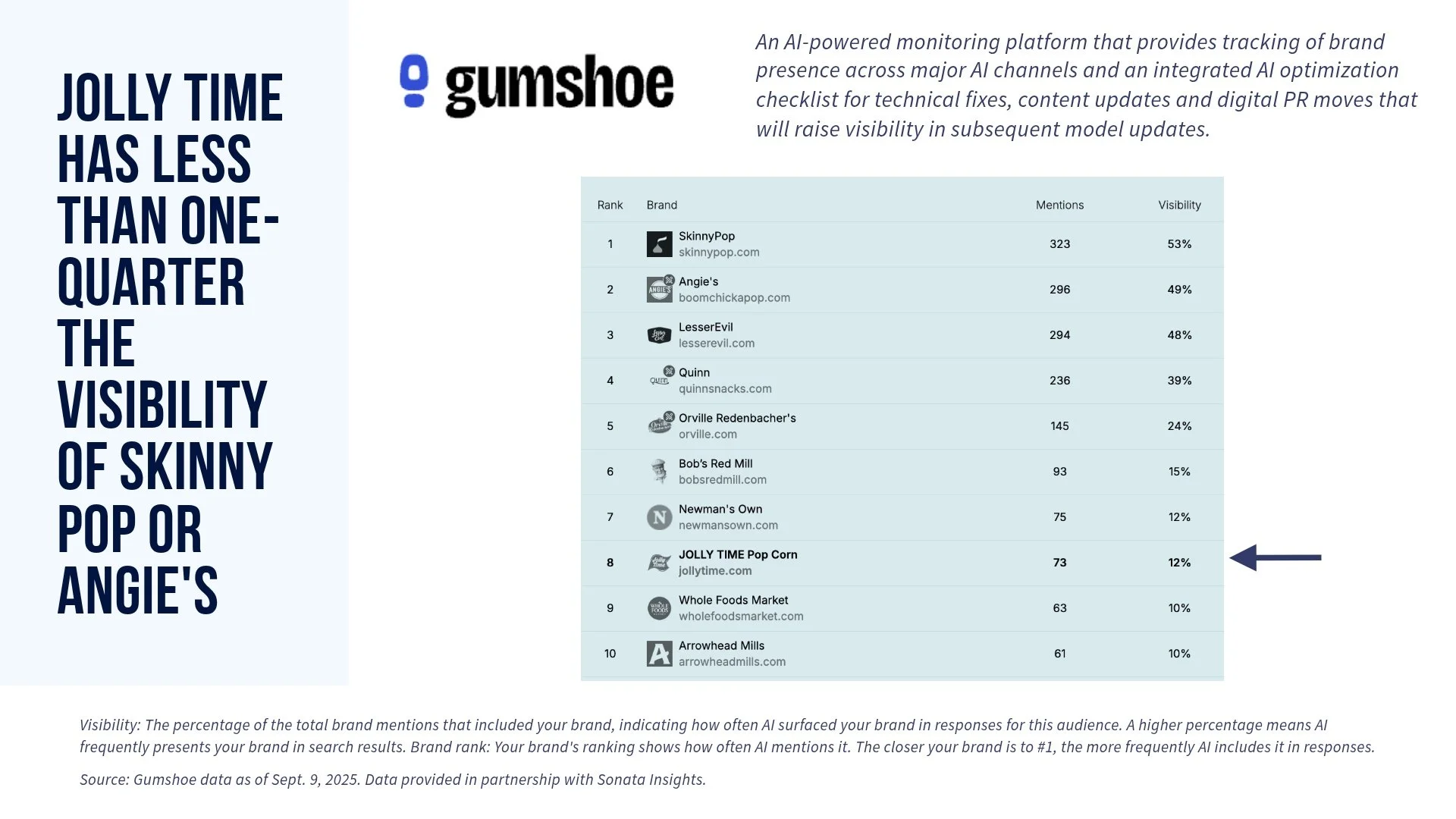What an Iowa Popcorn Brand Taught Me About Optimizing for AI Search
This article was inspired by data from Gumshoe AI. (Paid partnership)
When I spoke recently to a group of marketers in Iowa, I decided to do something fun. I wanted to give them a glimpse of how a local brand—Jolly Time Popcorn—shows up in AI search.
So I ran an experiment.
Using data from Gumshoe AI, a Seattle-based company that tracks how brands appear across AI chatbots and recommendation engines, I looked at what happens when someone searches for “healthy snack options” on AI platforms.
The results?
Jolly Time didn’t show up much at all.
In fact, Gumshoe data showed that Jolly Time had only about a quarter of the visibility that brands like SkinnyPop or Angie’s Boomchickapop enjoyed in AI search results for “healthy snack options.”
Even more interesting, when I narrowed the search to a specific persona—say, a weight-conscious empty nester—Jolly Time disappeared entirely.
Why this matters
You might say Jolly Time - creator of the "blast o' butter" snack - isn't marketing itself as a healthy snack food. But in fact, it does have healthy snack options, including 100-calorie packs and bags of popcorn made with minimal ingredients. So there's a benefit to promoting those line extensions in AI search.
The bigger issue facing brand like Jolly Time is that control has shifted. In a pre-AI world, consumers might have typed a search into Google and decided for themselves which links they wanted to visit.
But when consumers type a query into ChatGPT or read an AI Overview on Google, the control leaves their hands. ChatGPT and Google choose what brands to show them. Not showing up in the responses means being invisible at a time when someone is open to finding something new.
How brands can adapt
Audit your AI visibility. Understand where and how your brand appears when consumers ask AI chatbots for advice or recommendations.
Update your content strategy. AI models respond to context-rich content—clear product benefits, authentic reviews and educational blog posts often perform better than keyword-heavy SEO copy.
Invest in optimization. Consider rebalancing some of your SEO or advertising spend toward improving your AI search presence. That might include refreshing website content, publishing AI-friendly summaries, or generating new assets that describe your brand in plain, consumer-centric language.
Brands can also publish new content that is aimed at improving their showing in AI search. This is where companies like Gumshoe can help. I used Gumshoe to create a few new content assets based on existing materials from Jolly Time's website. If the brand were to publish human-reviewed and human-edited versions of those assets (I never recommend using AI tools without human oversight and intervention), it could help AI crawlers to better understand—and potentially recommend—the brand in the future.
The bigger picture
What’s happening right now in AI search is just the beginning. Soon, we may see direct transactions and automated purchasing happening inside AI platforms, driven by intelligent agents that act on behalf of consumers.
That makes visibility in AI search more important than ever.
Brands that take the time to understand how they appear—and make the right content investments now—will be best positioned for that next phase.
Gumshoe AI is an AI-powered monitoring platform that provides tracking of brand presence across major AI channels and an integrated AI optimization checklist for technical fixes, content updates and digital PR moves that will raise visibility in subsequent model updates. This article was written in partnership with Gumshoe, which provided access to the data.



